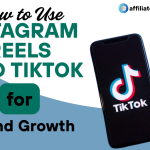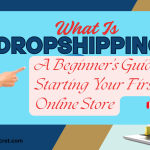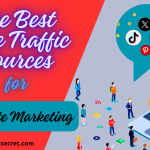Welcome to my article on “What Is Dropshipping? A Beginner’s Guide to Starting Your First Online Store”.So, you’ve been scrolling through TikTok, watching people claim they made $10,000 in a week selling cat-themed coffee mugs — and now you’re wondering, “What in the world is dropshipping, and how do I get in on this?” Well, you’re in the right place. Dropshipping is one of the easiest (and cheapest) ways to start your own online business — no warehouse required, no boxes in your garage, and no awkward conversations with the post office clerk. In this beginner-friendly guide, we’ll walk you through exactly what dropshipping is, how it works, and how you can get started with your very own online store — even if the only thing you’ve ever sold is a used chair on Facebook Marketplace.
But before you dive in and spend your life savings on a logo, let’s be clear: dropshipping isn’t some magic money machine. It’s a real business model that requires real effort, smart decisions, and, yes, probably a few late-night YouTube tutorials. We’re here to break it all down for you — no fluff, no jargon, and no unrealistic promises. Whether you’re dreaming of quitting your 9-to-5 or just want a side hustle to fund your caffeine addiction, this guide will give you the tools and know-how to start your dropshipping journey with confidence (and maybe even a little fun). Let’s get into it — your future ecommerce empire awaits. 🛒
My Best Recommended & Proven Way to Make $100-$300 Daily – Watch This FREE Video to START >>>

What Is Dropshipping and How Does It Work?
Imagine opening an online store where you don’t have to buy inventory upfront, pack boxes, or even touch the product. Sounds like a scam, right? Well, surprisingly, it’s not. That, dear reader, is the magic of dropshipping — a retail model where you sell products without ever stocking them yourself.
Here’s how it works: You set up an online store and list products (like LED dog collars or novelty burrito blankets). When someone places an order, you don’t ship the product — your supplier does. You just pass along the customer’s order and shipping details to your supplier, who then ships the product directly to your customer’s doorstep. You keep the difference between what the customer paid and what the supplier charges you. It’s basically like being a middleman, but with more marketing and fewer awkward conversations.
The beauty of dropshipping is that it lowers the barrier to entry. You don’t need thousands of dollars to invest in inventory or rent out warehouse space. All you really need is a laptop, some Wi-Fi, and a questionable amount of caffeine. Oh, and a little patience — because while it’s simple, it’s not “get-rich-overnight” easy.
Let’s break it down into a quick flow:
- You choose a niche and products (from a supplier platform like AliExpress, Spocket, or DSers).
- You list the products on your online store (using Shopify, WooCommerce, etc.).
- A customer places an order.
- You forward the order to the supplier, who ships it directly to the customer.
- You profit. Hopefully.
Now, there are a few caveats. You don’t control inventory, shipping times can be long (especially if your supplier is halfway across the planet), and returns can be… a bit of a headache. But if you choose your suppliers wisely and set clear expectations with customers, dropshipping can absolutely work — and scale.
So yes, you can sell flamingo pool floats or minimal Scandinavian desk lamps without turning your home into a mini Amazon warehouse. It’s all about smart strategy, good suppliers, and being willing to learn the ropes (with a little help from guides like this one).
Why Dropshipping Is a Popular Business Model
Let’s be honest: starting a business the traditional way is… kind of terrifying. You sink thousands into products you hope people want, rent storage space you hope you’ll need, and cross your fingers that you don’t end up with a garage full of unsold beard oil. Dropshipping flips that scary equation on its head — and that’s exactly why it’s so popular.
The biggest reason dropshipping has exploded in popularity? Low startup costs. You don’t need to buy inventory in bulk. In fact, you don’t need to buy anything until someone pays you. That means you can test product ideas and niches with minimal risk — and maximum potential. If your idea flops? Change products, not your life savings.
Another selling point? No inventory management. You won’t have to count boxes, print shipping labels, or spend your Saturday nights bubble-wrapping mugs. Your supplier handles that part. You focus on what matters most: branding, marketing, and binge-watching tutorials on how to write better product descriptions.
Oh, and let’s not forget the flexibility. You can run a dropshipping store from your couch, a coffee shop, or a beach in Bali (Wi-Fi permitting, of course). This level of location independence makes dropshipping especially appealing to digital nomads, stay-at-home parents, and side-hustlers looking to escape the 9-to-5 hamster wheel.
My Best Recommended & Proven Way to Make $100-$300 Daily – Watch This FREE Video to START >>>
But wait — there’s more! (Said in our best infomercial voice.)
Dropshipping also gives you the ability to scale fast. Since you’re not physically handling the products, you can sell 10 or 10,000 units without having to upgrade to a forklift. If your marketing takes off (hello, viral TikTok), your supplier handles the heavy lifting while you manage the growth.
Now, to be clear, dropshipping isn’t all sunshine and overnight Lamborghinis. Profit margins can be thin, shipping times can be long (especially from overseas suppliers), and quality control isn’t always in your hands. But for many entrepreneurs, the pros outweigh the cons, especially when starting out.
So why is dropshipping so popular? Because it lowers the risk, reduces the upfront cost, and makes starting an online business feel a little more doable — even if you’ve never sold anything online in your life. It’s not perfect, but it’s accessible, scalable, and full of potential.
And hey, it beats stacking boxes in your living room, right?
How to Start a Dropshipping Store Step-by-Step
Alright, so you’re sold on the idea: no inventory, no warehouse, no forklift license required. Great. But now you’re probably thinking, “Okay… but how do I actually start a dropshipping store?” Don’t worry — it’s not as complicated as it sounds. If you can post on Instagram and use a shopping cart (the online kind, not the supermarket kind), you’re halfway there.
Here’s your no-fluff, beginner-friendly step-by-step guide to launching your very own dropshipping store:
Step 1: Choose a Niche (That Doesn’t Suck)
Don’t just pick something random like “stuff for everyone” — that’s a fast track to selling nothing. Your niche should be something specific, ideally something you’re interested in and people are already buying. Think: eco-friendly kitchen tools, dog mom merch, or ergonomic desk gadgets for the work-from-home crowd.
Pro tip: Use tools like Google Trends, TikTok, and keyword planners to check if your niche is hot… or just lukewarm.
Step 2: Find a Supplier You Can Trust
Your supplier is basically your silent business partner. Choose the wrong one, and you’ll have angry customers, slow shipping, and a lot of refund requests in your inbox.
Platforms like AliExpress, Spocket, Zendrop, and DSers let you connect with suppliers quickly — just make sure to vet them by checking reviews, ratings, and sample orders if possible.
Avoid: sketchy suppliers with no reviews, blurry product photos, or shipping estimates that require time travel.
Step 3: Set Up Your Online Store
Next up: building your digital storefront. You don’t need to code or know what HTML stands for (although it’s “HyperText Markup Language” if you’re feeling fancy).
- Shopify is the most popular dropshipping platform — easy to use and built for ecommerce.
- WooCommerce is great if you’re already familiar with WordPress.
- There are also other options like Wix and BigCommerce if you like to explore.
Choose a clean theme, add your logo (Canva is your best friend), and make sure your site doesn’t look like it was made in 2009.
Step 4: Add Products and Set Your Prices
Pull in your products using an app like DSers (for AliExpress) or Spocket. Make sure to:
- Write clear, benefits-focused product descriptions
- Use high-quality images (please, no pixelated nonsense)
- Set a price that covers costs and makes a profit (most dropshippers aim for 30–50% margins)
Bonus points if you rename the products so they don’t all sound like “Portable 3-in-1 USB Hairbrush 2022.”
Step 5: Launch and Promote Like a Pro
Your store is ready. Time to bring in some eyeballs — and customers.
- Start with organic content: Instagram, TikTok, Pinterest, or YouTube
- Use paid ads (like Facebook or TikTok Ads) to test winning products
- Build an email list for long-term sales (use a free tool like Mailchimp)
- Consider using influencers or UGC (user-generated content) to create trust and hype
There you have it: your step-by-step game plan. No business degree required, no expensive course needed, just some hustle and a decent Wi-Fi signal. The key is to start small, learn as you go, and remember — even the biggest ecommerce stores started with one product and a little courage.
Let’s move on — because now that you know how to start, you’ll need the tools to keep it running smoothly.
Essential Tools and Platforms for Dropshippers
Let’s be real: dropshipping without tools is like trying to cook a gourmet meal with just a spoon. Technically possible? Maybe. Efficient, scalable, and stress-free? Definitely not. The good news is, there are a ton of tools and platforms that make running your dropshipping business way easier — some even do the heavy lifting while you sleep (which is peak entrepreneurial efficiency, let’s be honest).
Here’s a breakdown of the must-have platforms and tools to make your dropshipping store run like a well-oiled ecommerce machine.
My Best Recommended & Proven Way to Make $100-$300 Daily – Watch This FREE Video to START >>>
1. Ecommerce Platforms (a.k.a. Your Online Store HQ)
This is where the magic happens — your digital storefront.
- Shopify: Hands-down the most popular platform for dropshippers. It’s beginner-friendly, has tons of apps, and integrates seamlessly with most dropshipping tools. Plus, it looks professional even if you built it in your pajamas.
- WooCommerce: Great if you love WordPress or want more customization. It’s powerful and flexible — but can get a little technical. Not for the faint of heart (or the easily frustrated).
- BigCommerce & Wix: Good alternatives with solid features, but Shopify is still king in the dropshipping space for a reason.
2. Product Sourcing Tools (So You’re Not Manually Copy-Pasting Orders at 2 AM)
These tools connect you to suppliers and automate product import, pricing, and order fulfillment.
- DSers: The go-to tool for working with AliExpress suppliers. It’s fast, free (with premium options), and helps you fulfill dozens of orders with a few clicks.
- Spocket: Great if you want faster shipping and US/EU-based suppliers. Slightly pricier products, but better customer experience.
- Zendrop: Combines automation with decent shipping times and a clean interface. Ideal for beginners who want ease-of-use over deep customization.
- CJ Dropshipping: Offers product sourcing, custom packaging, and global suppliers — but the interface might test your patience.
3. Marketing Tools (Because “Build it and they will come” is a lie)
Nobody’s buying if nobody knows your store exists. These tools help you get the word out.
- Canva: Create ads, banners, and social media posts even if your graphic design skills peaked in kindergarten. Canva makes you look like a pro.
- Facebook Ads Manager: The powerhouse of paid advertising. A bit of a learning curve, but wildly effective when used right.
- TikTok Ads: For the brave, the trendy, and the brave and trendy. If your product can go viral, TikTok might be your best friend.
4. Email Marketing & Customer Communication
Once you’ve got traffic, don’t let visitors vanish forever.
- Klaviyo or Mailchimp: Build email lists, set up abandoned cart flows, and actually follow up with customers (instead of ghosting them).
- Tidio or Chatra: Live chat apps to help answer questions, build trust, and close sales faster than your competitors can say “free shipping.”
5. Analytics & Optimization (Nerdy, But Necessary)
- Google Analytics: See where your traffic’s coming from, what people are doing on your site, and how to improve it.
- Hotjar: Offers heatmaps and screen recordings so you can watch customers struggle to find your “Add to Cart” button — and fix it.
In short: having the right tools is the difference between running a business and running around like a headless chicken. These platforms will help you save time, look professional, and actually grow — instead of just hoping someone stumbles onto your store and buys a unicorn-shaped lamp.
Ready to wrap things up? Next we’ll dive into final tips for success — and a few classic mistakes you’ll want to avoid like expired milk. 🧃
Final Tips for Success and Common Mistakes to Avoid
Now that you’re practically a dropshipping guru (or at least dropshipping-curious), let’s talk about how to actually succeed — and how to avoid crashing your store into the ecommerce equivalent of a brick wall.
Because yes, dropshipping is a simple model, but like any business, it’s also very easy to mess up. Don’t worry — we’ve got your back. Here are some final tips for success, plus a few rookie mistakes that even seasoned sellers sometimes make (we see you, Todd).
✅ Tip #1: Focus on Customer Experience — Not Just Sales
Sure, it’s exciting when someone buys that Bluetooth banana peeler you’re selling. But if it arrives late, broken, or wrapped in mystery packaging from a supplier who clearly gave up on life — guess who gets the angry email? You.
Keep communication clear, respond quickly to questions, and choose suppliers with good reviews and reliable shipping. Good customer service is your competitive advantage.
✅ Tip #2: Branding Matters More Than You Think
Here’s the thing: anyone can sell the same phone case from AliExpress. What makes your store stand out is the brand you build. Use consistent colors, create a logo, write product descriptions that don’t sound like they were translated by a toaster — and tell a story that makes people want to buy from you.
A generic site feels sketchy. A branded site feels legit. Go with legit.
✅ Tip #3: Test Products Before Scaling
Don’t dump your life savings into Facebook Ads on Day 1. Test different products and audiences with small budgets. Once something clicks — scale it. Think of testing like dating: you don’t propose after one good conversation. (Hopefully.)
✅ Tip #4: Track Everything
Use Google Analytics, Facebook Pixel, and email open rates to see what’s working. If you’re not tracking performance, you’re basically driving with your eyes closed — and we’re trying to make money here, not reenact a crash scene.
✅ Tip #5: Keep Learning and Adapting
The ecommerce world changes faster than TikTok trends. Algorithms shift. Products go viral. Shipping costs spike. Be ready to pivot. Follow ecommerce blogs, join Facebook groups, and never assume you’ve “figured it all out.” You haven’t. No one has. That’s half the fun.
🚫 Common Mistakes to Avoid Like the Plague
- Underpricing your products: Low prices don’t always equal more sales — sometimes they scream “cheap and sketchy.” Factor in your margins, ad costs, and shipping.
- Ignoring shipping times: If your product takes 28 days to arrive from the moon, make that very clear in your store — or expect refunds and rage.
- Copy-pasting product descriptions: Everyone else is doing that too. Stand out with your own voice (ideally not robot-sounding).
- Selling copyrighted or trending products without research: Don’t try to dropship Disney mugs or fake Apple gear. Legal trouble isn’t a fun niche.
- Giving up too soon: Your first product might flop. Your first ad might tank. That’s normal. Learn, tweak, test again. Winners don’t quit after their first awkward landing page.
🚀 Wrapping It Up
Dropshipping can be a great entry point into ecommerce — but it works best when you treat it like a real business, not a magic vending machine. With the right tools, mindset, and a bit of hustle (and probably some caffeine), you can build something amazing from scratch.
Now go out there, launch your store, and sell something weird-but-useful to the internet. You’ve got this.
Conclusion: So, Is Dropshipping Right for You?
If you’ve made it this far — congratulations! You now know more about dropshipping than 99% of people who say, “I want to make passive income online.” And while it’s not quite the mythical “make money while you sleep with zero effort” model some YouTube ads promise, it is a solid, beginner-friendly way to break into ecommerce without maxing out your credit card on warehouse space.
To recap:
- You don’t need to buy inventory upfront
- You don’t need to ship products yourself
- You do need to choose a niche, find trustworthy suppliers, build a good-looking store, and market like you mean it
The beauty of dropshipping is that it’s low-risk and high-flexibility. You can run your store from your laptop in your living room — or a beachside café, if you’re feeling extra Instagram-worthy. You can test products, pivot quickly, and scale up if things take off. It’s like a business sandbox with real money involved.
My Best Recommended & Proven Way to Make $100-$300 Daily – Watch This FREE Video to START >>>
That said, it’s still a business — not a magic ATM. You’ll have to learn, adapt, and probably mess up a few times along the way (that’s part of the fun, right?). But with the right tools, smart strategies, and a solid internet connection, you’re more than capable of turning this thing into something profitable.
So, is dropshipping for you? Only one way to find out:
Start small, start smart — and just start. 🚀
Thanks a lot for reading my article on “What Is Dropshipping? A Beginner’s Guide to Starting Your First Online Store” till the end. Hope you’ve helped. See you with another article.










